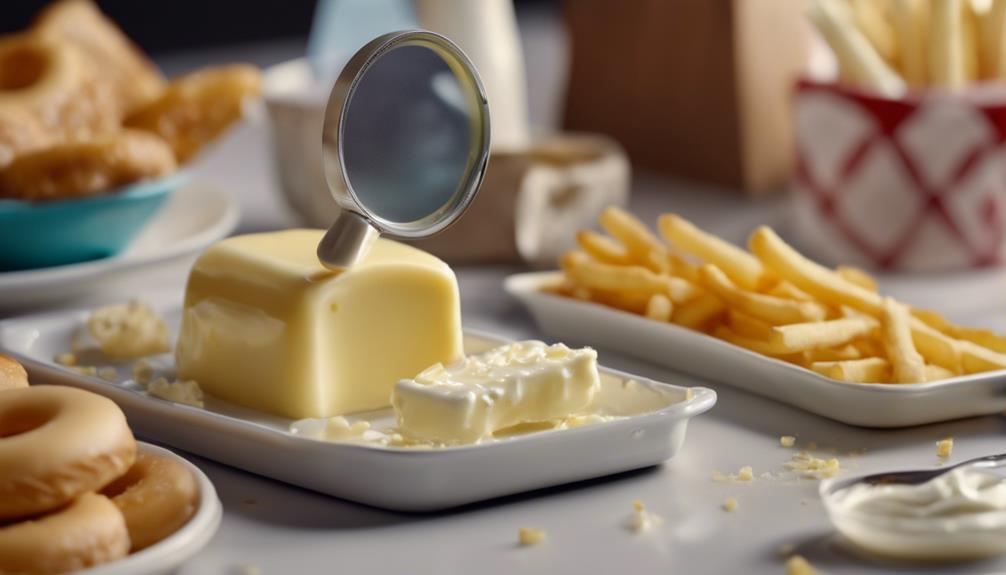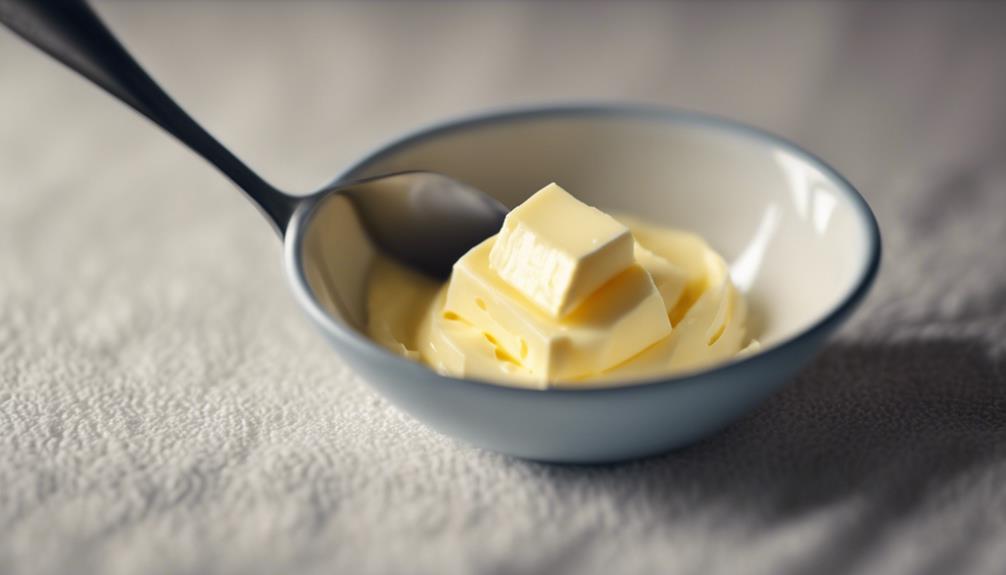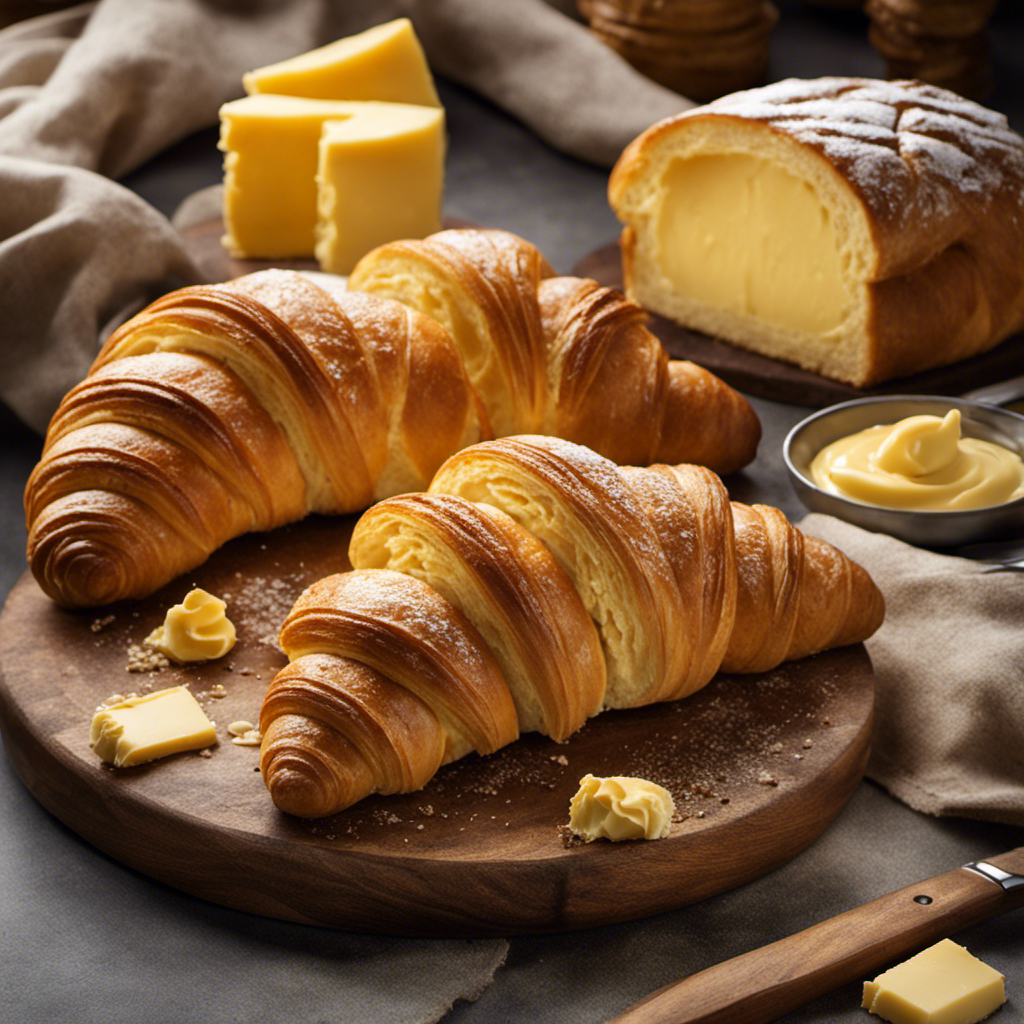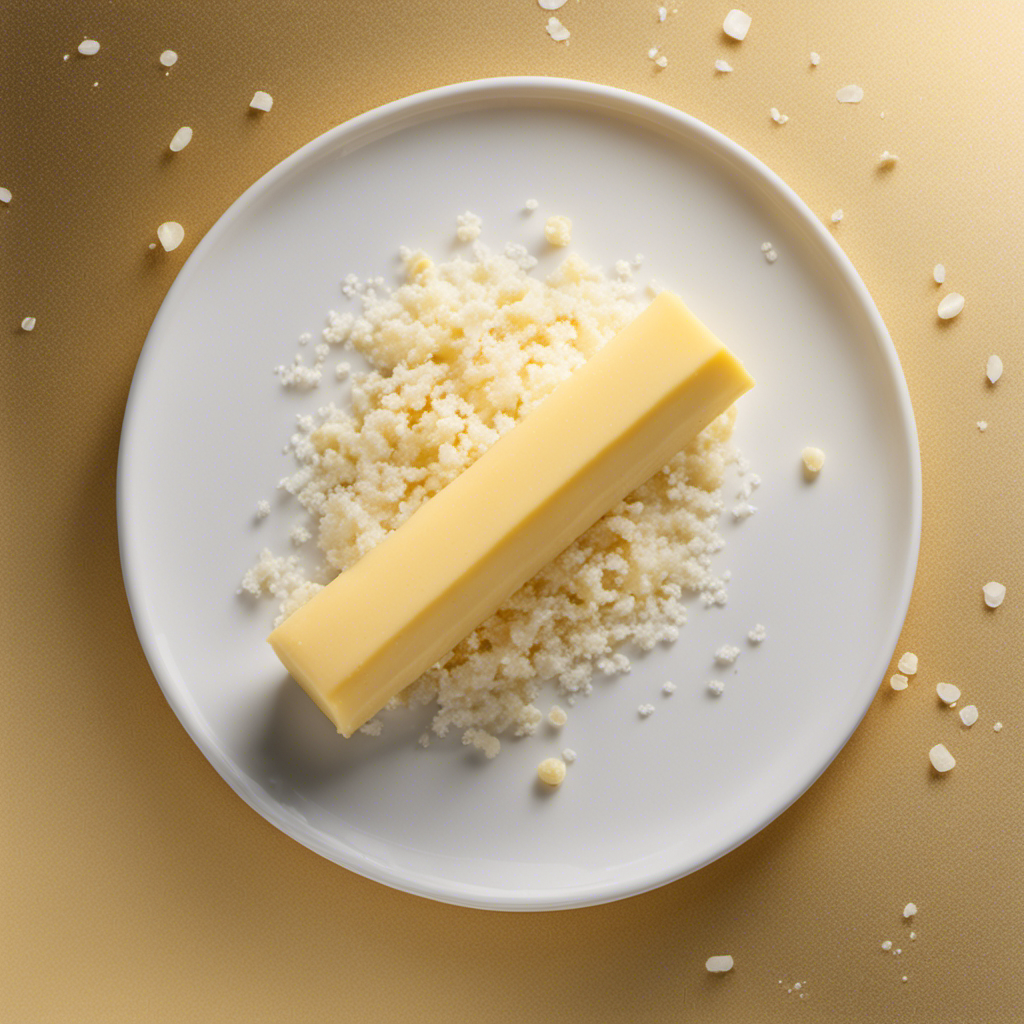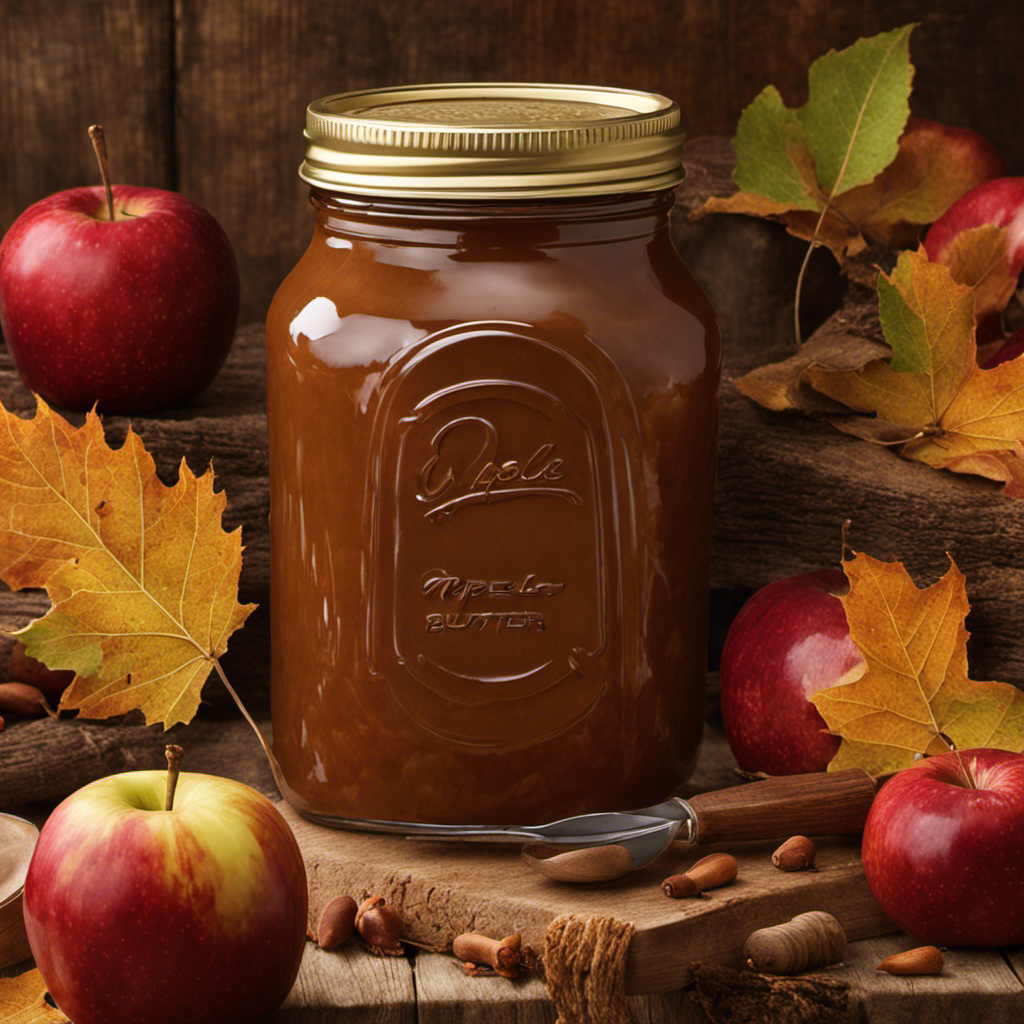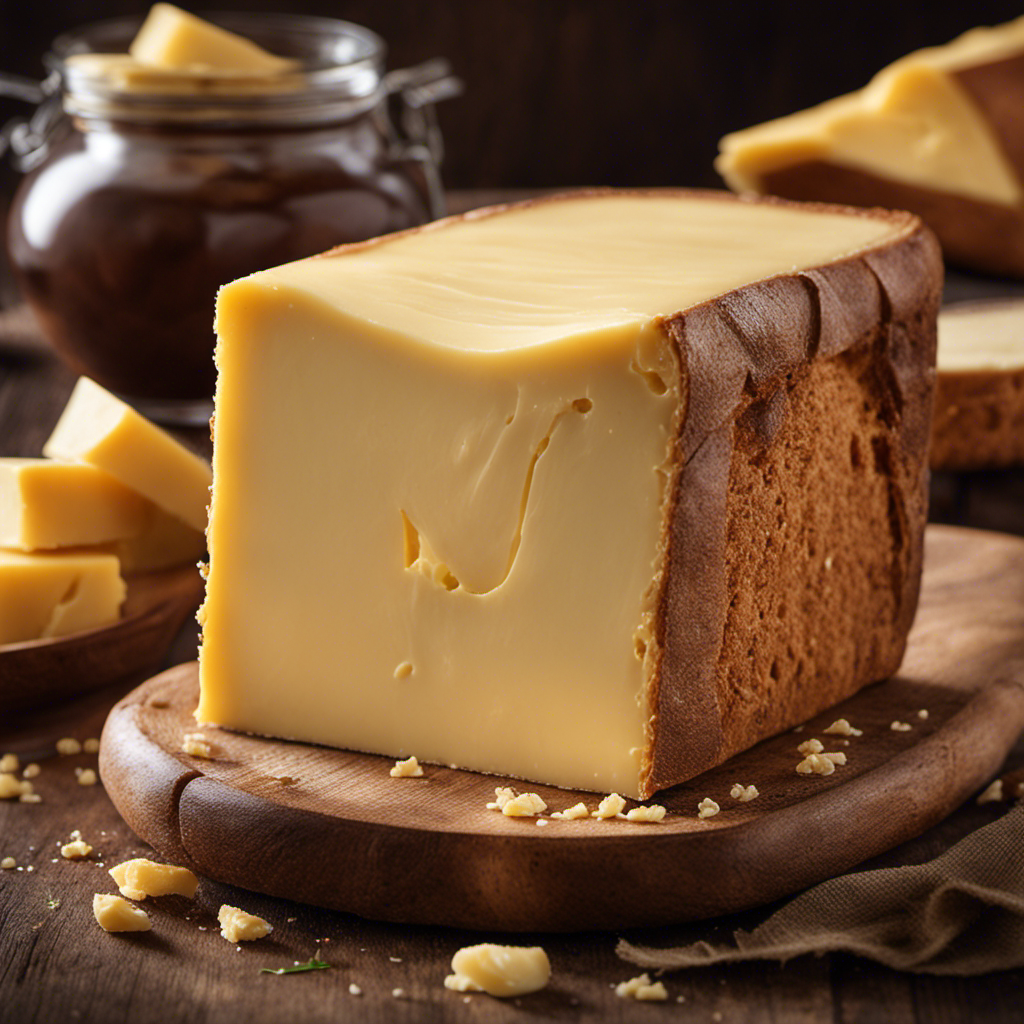Trans fats in butter, though in small amounts, can raise your bad cholesterol (LDL) and lower your good cholesterol (HDL), increasing heart disease risk. Butter contains naturally occurring trans fats, but the bigger concern is artificial trans fats found in many processed foods. Trans fats improve taste and shelf life, but their health risks have led to stricter FDA regulations and a shift towards alternative ingredients. Understanding the sources and health implications of trans fats can help you make better dietary choices. There's a lot more to uncover about ongoing regulations and healthier alternatives.
Key Takeaways
- Butter contains small amounts of naturally occurring trans fats derived from meat and dairy sources.
- Trans fats in butter raise bad cholesterol (LDL) and lower good cholesterol (HDL), increasing heart disease risk.
- Despite health risks, trans fats enhance butter's taste, shelf life, and cost-effectiveness.
- Regulatory actions limit artificial trans fats in processed foods, but naturally occurring trans fats in butter remain.
- Consumer awareness and FDA regulations have shifted to highlight the health risks of trans fats.
What Are Trans Fats?
Trans fats are unsaturated fats that come in both natural and artificial forms, with the latter being chemically altered from vegetable oils. Artificial trans fats, often found in partially hydrogenated oils, were once common in many processed foods. These fats can be particularly harmful to your health.
When you consume foods containing artificial trans fats, they can raise your LDL cholesterol levels. LDL cholesterol, often referred to as 'bad' cholesterol, contributes to the buildup of plaque in your arteries, which increases your risk of heart disease. At the same time, trans fats can lower your HDL cholesterol, which is the 'good' cholesterol that helps remove LDL cholesterol from your bloodstream. This double whammy makes trans fats especially dangerous.
Partially hydrogenated oils were a major source of trans fats, and they were used to improve the shelf life and texture of many processed foods. Thankfully, many countries have recognized these health risks and have implemented restrictions to limit trans fats in processed goods.
To protect your heart health, always check food labels for partially hydrogenated oils. Avoiding these can help you reduce your intake of artificial trans fats and maintain healthier cholesterol levels.
Types of Trans Fats
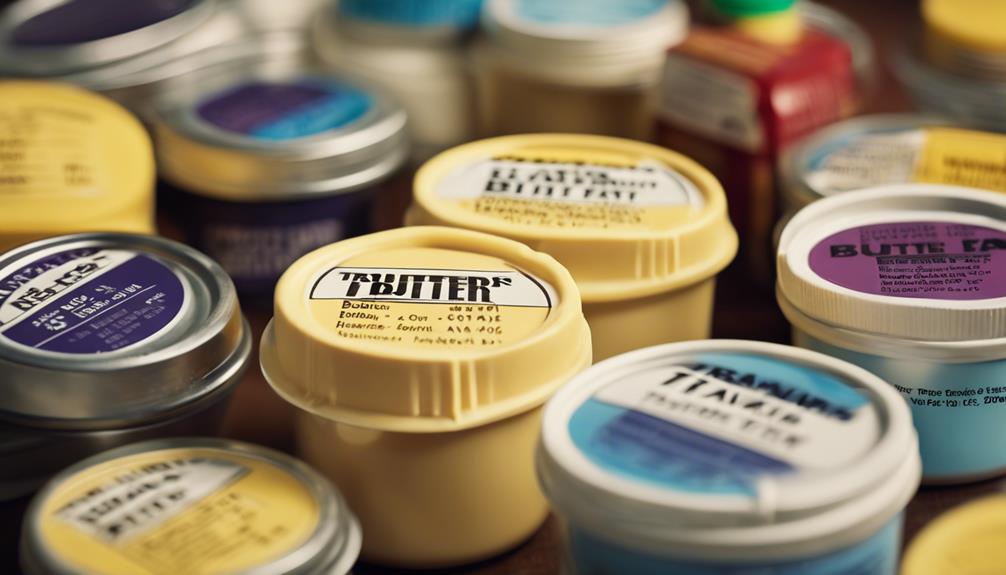
While understanding the health risks of trans fats is important, it's also essential to distinguish between the two types: naturally-occurring and artificial trans fats.
Naturally occurring trans fats are found in small amounts in the meat and dairy products of ruminant animals like cows and sheep. These trans fats are produced naturally in the stomachs of these animals and end up in products like butter and cheese.
On the other hand, artificial trans fats are created through an industrial process called hydrogenation, where hydrogen is added to vegetable oils. This process makes the oils solid at room temperature, which is useful for creating items like margarine and many baked goods. However, artificial trans fats have been shown to have a much more significant negative impact on heart health compared to their naturally occurring counterparts.
Here's a quick breakdown to help you understand better:
- Naturally occurring trans fats: Found in meat and dairy from ruminant animals.
- Artificial trans fats: Created through hydrogenation of vegetable oils.
- Health impact: Artificial trans fats are more harmful to heart health.
- Regulation: The FDA has acted to reduce artificial trans fats in the food supply.
Understanding these differences can help you make healthier dietary choices.
Sources of Trans Fats

In your daily diet, you can find trans fats in both natural and processed foods. Butter contains small amounts of naturally occurring trans fats because it's derived from ruminant animals like cows. These natural trans fats are present in minor quantities and don't pose the same health risks as artificial trans fats.
However, you'll find that processed foods are the main culprits when it comes to high levels of trans fats. These foods often contain partially hydrogenated oils, which are artificially created to improve shelf life and texture. Products like margarine, baked goods, and snack foods are common sources of these harmful trans fats.
Butter itself doesn't typically contain artificial trans fats unless it has added partially hydrogenated oils. This is rare, but it's always a good idea to check the ingredient label to be sure. If you see 'partially hydrogenated oils' listed, that butter has added trans fats, and it's best to avoid it.
Health Risks
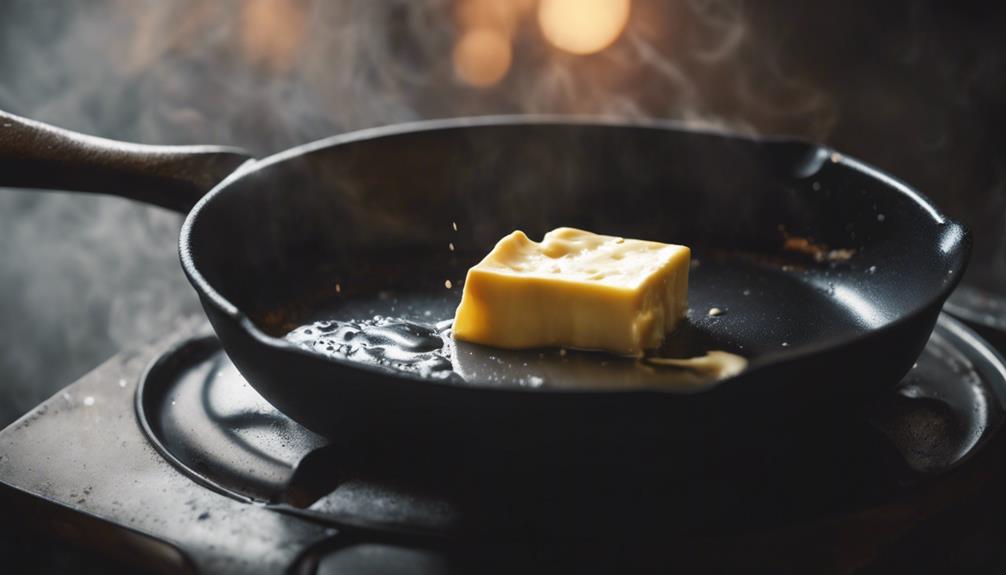
When you consume butter with trans fats, you're raising your bad cholesterol levels and lowering the good ones, which can put you at risk for heart disease.
This cholesterol imbalance is a serious concern that can lead to clogged arteries and other cardiovascular issues.
Limiting your intake of these harmful fats is essential for maintaining heart health.
Cholesterol Imbalance Concerns
Trans fats in butter can greatly disrupt your cholesterol balance, putting you at a higher risk for heart disease and stroke. When you consume butter high in trans fats, it raises your LDL (bad) cholesterol levels. This buildup of LDL cholesterol can clog your arteries, making it harder for blood to flow and increasing the likelihood of cardiovascular issues.
Moreover, trans fats in butter can lower your HDL (good) cholesterol levels. HDL cholesterol helps remove excess LDL cholesterol from your bloodstream, so when HDL levels drop, the risk of heart disease becomes even greater. Health experts consistently warn about the negative impact of trans fats on your overall heart health.
Managing your cholesterol balance is essential for long-term health. Here are key points to keep in mind:
- Limit Butter Intake: Reduce consumption of butter high in trans fats to help maintain a healthy cholesterol balance.
- Read Labels Carefully: Look for products labeled 'trans fat-free' to avoid hidden sources of these harmful fats.
- Choose Alternatives: Opt for healthier fat sources like olive oil or avocado, which don't negatively impact cholesterol levels.
- Regular Check-ups: Monitor your cholesterol levels through regular medical check-ups to stay on top of any imbalances early on.
Heart Disease Risk
Understanding how trans fats in butter affect your cholesterol balance is the first step to recognizing their role in increasing heart disease risk. When you consume butter containing trans fats, these harmful fats raise your bad cholesterol levels and lower your good cholesterol. This imbalance in cholesterol levels can clog your arteries, leading to a higher likelihood of developing heart disease and even stroke.
Trans fats in butter don't just impact your cholesterol; they've a broader negative effect on your cardiovascular health and overall well-being. Regular consumption of butter with trans fats can result in long-term damage to your heart, making it essential to monitor and moderate your intake.
The increased heart disease risk from these fats underscores the importance of being vigilant about the types of fats you're incorporating into your diet.
Why Companies Use Them

Companies use trans fats in butter because they enhance taste and texture, making the product more appealing to consumers. You'll find that the smooth, spreadable consistency is a big reason why trans fats are so common in butter. Despite the health risks, companies continue to use trans fats because of their significant advantages in food processing.
Here are four key reasons why companies stick with trans fats in butter:
- Taste and Texture: Trans fats improve the mouthfeel and flavor profile, making butter more delicious and satisfying.
- Extended Shelf Life: Butter with trans fats lasts longer, reducing waste and making it a favorite for commercial food production.
- Cost-Effectiveness: Trans fats are cheaper than other alternatives, making them an economical choice for restaurants and fast-food outlets.
- Convenience: They keep butter solid at room temperature, which is ideal for spreading and cooking.
Popularity History
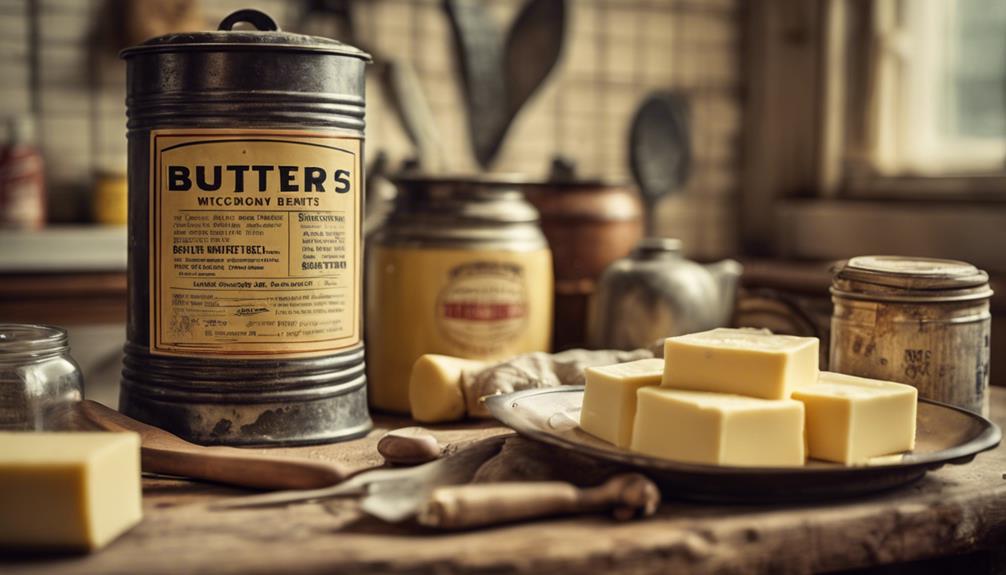
You might be surprised to learn that trans fats in butter gained popularity as processed foods became widespread.
Early on, many believed trans fats were harmless, making them a staple in kitchens.
As consumer awareness grew, however, the demand for healthier alternatives began to shift.
Rise in Processed Foods
How did the 20th century's surge in processed foods lead to an explosion in trans fat consumption?
The rise in popularity of processed foods during this period meant that trans fats became a staple in many households. These fats were prized for their ability to enhance taste, improve texture, and extend the shelf life of foods. However, the widespread use of trans fats in processed foods came with significant health risks.
The widespread usage of trans fats in many fast-food outlets and restaurants to enhance flavor and preserve food made them a common part of daily diets. Unfortunately, the health risks associated with these fats weren't well-known until research in the 1990s brought their dangers to light. This led to regulatory actions aimed at reducing trans fats in foods.
Here's a quick summary to help you understand the key points:
- Popularity: Processed foods became highly popular in the 20th century.
- Usage: Trans fats were widely used for taste, texture, and preservation.
- Health Risks: Lack of awareness about health risks led to widespread consumption.
- Regulation: Research in the 1990s led to regulatory actions to reduce trans fats.
Early Misconceptions on Health
For much of the 20th century, people frequently believed that trans fats in butter were harmless, unaware of the emerging health risks. You might remember that during this time, butter and other products containing trans fats were incredibly popular. This was mainly because there was little awareness about the detrimental health effects these fats could have on your body.
It wasn't until the 1990s that research started revealing the true dangers of trans fats. Scientists found that these fats could notably increase your risk of heart disease, stroke, and other serious health conditions. With this new information, public perception began to shift, and people started to question the safety of consuming trans fats in butter and other foods.
The FDA responded to these findings by implementing regulations on trans fat labeling. This move prompted many manufacturers to reduce or eliminate trans fats from their products, including butter. However, despite these measures, some individuals still consume high levels of trans fats, either because of a lack of awareness or the continued availability of certain products.
Recognizing the ongoing risks, several countries and jurisdictions have implemented stricter restrictions on trans fats in butter to protect public health.
Shift in Consumer Awareness
As research in the 1990s highlighted the dangers of trans fats, consumer awareness began to shift, leading to a decrease in the popularity of butter and other products containing these harmful fats. You probably remember when butter was a staple in almost every kitchen, but as the health risks became clearer, people started looking for alternatives.
The FDA played a pivotal role by enforcing regulations that required trans fat labeling, making it easier for you to make informed choices.
Here's a quick rundown of how consumer awareness has evolved over time:
- 1990s Research: Studies revealed the negative impact of trans fats on heart health, prompting a shift in public perception.
- Regulations: The FDA's labeling requirements brought the issue to the forefront, encouraging consumers to opt for healthier options.
- Decreased Consumption: With greater awareness, the demand for butter containing trans fats declined significantly.
- Global Actions: Many countries have implemented strict regulations to limit trans fats in food products, further protecting public health.
Despite these advancements, some people still consume high levels of trans fats in butter. Staying informed about these health risks and regulations is vital for making healthier choices.
Foods Containing Trans Fats

Many processed foods and baked goods contain trans fats, posing significant risks to heart health. Foods containing trans fats often include items like margarine, snack foods, and some fast foods. These trans fats are usually derived from partially hydrogenated oils, which are added to improve shelf life and texture. However, consuming these foods can raise your bad cholesterol levels, increasing your risk of heart disease.
You'll also find trans fats in certain types of butter, especially those made with partially hydrogenated oils. It's vital to check ingredient lists for these oils to avoid trans fats. While butter itself can be a source, many other common foods contain them too. Frozen pizzas, cookies, and microwave popcorn are often culprits. Even some types of bread and crackers can contain hidden trans fats.
To protect your heart, it's wise to limit your consumption of foods high in trans fats. Opt for healthier alternatives like olive oil or avocado when cooking. Reducing your intake of trans fats isn't just about avoiding butter; it means being vigilant about all the processed foods you eat. Your heart will thank you for making these healthier choices.
FDA Actions
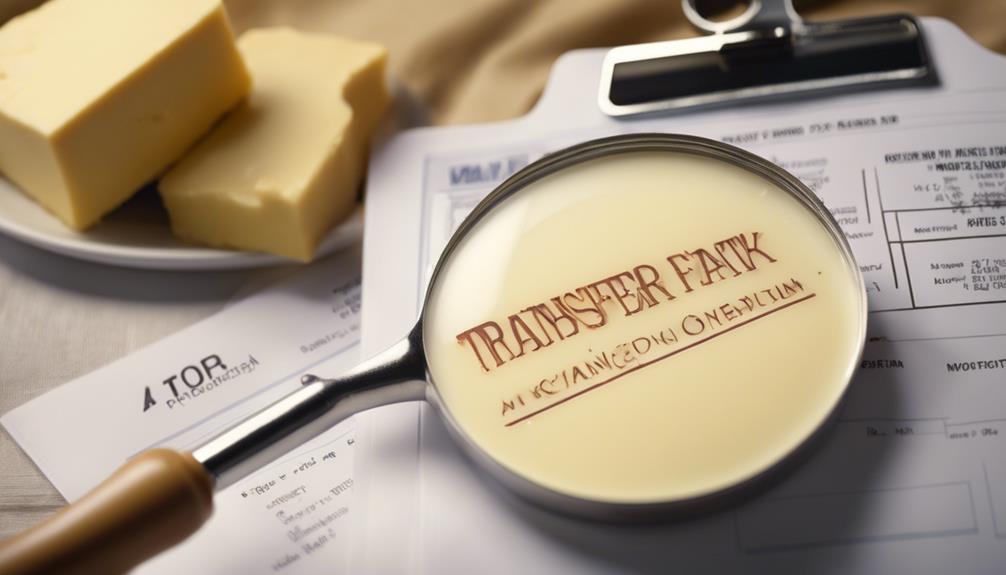
In 2015, the FDA took an essential step by determining that partially hydrogenated oils (PHOs) containing trans fats are no longer Generally Recognized as Safe (GRAS). This landmark decision aimed to curb the widespread use of artificial trans fats, which are linked to serious health risks. By June 18, 2018, most food manufacturers had to stop adding PHOs to their products, although the final compliance date was extended to January 1, 2021.
The FDA's actions have a clear goal: eliminating PHOs as a major source of artificial trans fats in the food supply. Here's a quick overview of what the FDA has done:
- 2015 Determination: Declared that PHOs containing trans fats are no longer GRAS.
- Compliance Deadlines: Set deadlines for removing PHOs from food products by 2018, with final compliance by 2021.
- Regulatory Updates: Finalized the removal of outdated PHO references in regulations through a 2023 direct final rule.
- Health Impact: These regulatory measures are estimated to prevent thousands of heart attacks and deaths annually.
The FDA's proactive stance on artificial trans fats is a pivotal step towards a healthier food supply and improved public health.
Reducing Intake at Home

To cut down on trans fat intake at home, start by replacing butter with healthier alternatives like olive oil or avocado. These options not only help reduce trans fats but also provide beneficial nutrients. For baking, you might try low-fat or non-hydrogenated margarine, which can be a good substitute for butter.
Choosing spreads labeled as trans fat-free is another effective way to lower your trans fat intake. Always check ingredient labels for partially hydrogenated oils, as these indicate the presence of trans fats. Opting for plant-based butter alternatives made from oils like coconut, almond, or soy can also help you cut down on unhealthy fats in your diet.
Here's a quick guide to healthier butter alternatives:
| Alternative | Benefits | Usage Tips |
|---|---|---|
| Olive Oil | Rich in healthy monounsaturated fats | Ideal for cooking and salads |
| Avocado | High in vitamins and antioxidants | Great for spreads and baking |
| Coconut Oil | Contains medium-chain triglycerides (MCTs) | Good for baking and sautéing |
Future Regulations

You'll want to stay informed about future regulations on trans fats as the FDA continues to monitor their levels in foods.
Ongoing collaborations with the food industry aim to reduce trans fat content, while researchers look for safer alternatives.
These efforts will shape regulations to better protect your health.
Monitoring Trans Fat Levels
Keeping an eye on trans fat levels in processed foods is crucial as the FDA works to enforce and possibly update future regulations. Monitoring these levels helps guarantee that all processed foods comply with existing regulations and maintain transparency in labeling. By understanding what's in your food, you can make better health choices and avoid harmful trans fats that can increase the risk of heart disease.
The FDA's ongoing efforts to regulate trans fats include:
- Regular Testing: Continuous testing of processed foods to make sure they meet current trans fat regulations.
- Transparent Labeling: Enforcing strict labeling requirements so you can easily identify trans fats on ingredient lists.
- Public Health Assessments: Conducting studies to evaluate the impact of trans fats on public health and determine if further action is necessary.
- Scientific Research: Investigating alternative ingredients to substitute partially hydrogenated oils, which are the primary source of trans fats.
Industry Collaboration Efforts
Frequently, industry leaders collaborate to identify and implement alternative ingredients to substitute harmful partially hydrogenated oils in processed foods. These collaborative efforts are essential for reducing trans fat content and improving public health outcomes. By working together, companies and regulatory bodies like the FDA can guarantee that processed foods are safer for you and your family.
| Collaboration Focus | Description |
|---|---|
| Alternative Ingredients | Developing substitutes for partially hydrogenated oils |
| Labeling Regulations | Ensuring accurate trans fat content on labels |
| Public Health Impact | Reducing overall trans fat consumption |
One of the key areas of focus is finding alternative ingredients that don't compromise the taste or quality of the food while eliminating partially hydrogenated oils. These substitutes aim to maintain the product's texture and shelf life without the harmful effects of trans fats.
Another vital aspect is labeling regulations. Clear and accurate labeling helps you make informed choices by knowing exactly what's in your food. The FDA continues to monitor and enforce these regulations, ensuring that companies comply with the latest standards.
Industry collaborations also prioritize the public health impact by seeking to reduce trans fat consumption across the board. This multi-faceted approach helps in creating a healthier food environment for everyone.
Alternative Ingredient Research
The FDA is stepping up efforts to identify and implement safer alternatives to partially hydrogenated oils in food manufacturing. By focusing on alternative ingredients, they aim to eliminate trans fats from processed foods, thereby improving public health.
This initiative is critical, as current research shows strong links between trans fats and numerous health issues, including heart disease.
To help you understand the importance of this research, here are four key points:
- Scientific Research: The FDA collaborates with scientists and the food industry to explore new fats and oils that can replace trans fats without compromising taste or texture.
- Industry Partnerships: Joint efforts with food manufacturers make certain that the alternative ingredients can be produced on a large scale and integrated seamlessly into processed foods.
- Public Health Focus: The primary goal of these efforts is to reduce the incidence of health problems associated with trans fats, contributing to overall public well-being.
- Future Regulations: Any updates to trans fat regulations will be based on rigorous scientific evidence, ensuring that the new standards effectively safeguard public health.
Stay informed about these developments to make healthier choices in your diet and support the movement towards safer food ingredients.
Frequently Asked Questions
Is Trans Fat in Butter Bad?
Trans fat in butter isn't a major concern. Natural trans fats in butter are minimal and unlikely to harm your health when consumed in moderation. Focus on avoiding artificial trans fats in processed foods for better health.
What Is the Healthiest Butter to Use?
Imagine spreading creamy, grass-fed butter on warm toast. You should choose butter from pasture-raised, organic cows for the best nutrients. European-style for richness or clarified butter for a lactose-free option are also excellent choices.
What Does Trans Fat Do to Your Body?
Trans fats raise your LDL cholesterol and lower your HDL cholesterol, making heart disease more likely. They also increase inflammation, which can lead to chronic diseases. Avoiding trans fats can enhance improve your overall health.
What Are the Healthy Fats in Butter?
Imagine indulging in creamy, delicious butter. You're not just savoring flavor; you're also consuming healthy fats! Butter boasts monounsaturated and polyunsaturated fats, especially if it's grass-fed. Enjoy these nutrients, but remember, moderation is key.
Conclusion
Imagine your body as a finely tuned engine. Trans fats are like sludge that clogs and corrodes your essential parts. By being mindful of what you eat, especially when it comes to butter and other processed foods, you can keep your engine running smoothly.
The FDA's actions and future regulations are like mechanics working to keep our engines clean. Make smart choices to guarantee your engine purrs, not sputters, through life's journey.
